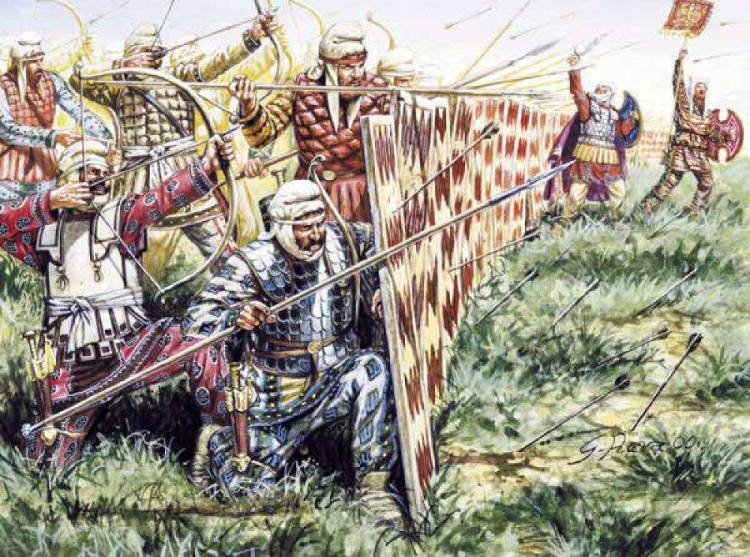10 facts that few people know about the ancient army of the Persian empire
Around 550 BC, Persians emerged as the most powerful military power in the Middle East. Here are 10 interesting facts about Persia.
Military training
From 5 to 20 years old, Persian boys were trained in archery and horseback riding. After this time, men will have to spend 4 years on military service and will be called back to military service in case of necessity. After 50 years of age, Persian men will be considered 'retired' and will no longer need to join the army.
Sparabara

Archery units are considered to be the backbone of the Persian army.
Archery units are considered to be the backbone of the Persian army. Therefore, Persians have a special type of soldier specialized in holding a shield pavises called 'sparabara' to protect archers. In a Persian archery unit, the number of 'sparabara' is always more than the number of archers - in contrast to the Assyians who often hold equal numbers of archers and soldiers.
Organize the squad
The Persian Army has a fairly modern way of organizing troops with a ratio of 1:10. Accordingly, the largest unit of the 'myriad' had a number of 10,000 soldiers, divided into 10 units 'hazarabam' (in Persian, 1,000). Next, each 'hazarabam' is made up of 10 'sataba' units and each 'sataba' consists of 10 'dathaba' units . It is known that all units have their own command of the current military organization in the world.
Equip infantry
Equipped with Persian infantry including curved blades and swords. Depending on the battle situation, the commanders of the 'dathaba' units could switch to using spears to better protect other soldiers.
Immortals
In the Persian army, the best soldiers are recruited into a 'myriad' called 'Amrtaka' (immortals). Amrtaka's core force is called 'Astibara' , which is responsible for directly serving and protecting the king. The people selected for 'Astibara' are often elite warriors of elite and have high status in Persian society.
Colonial soldiers
Like many other empires in history, Persians also used soldiers from occupied lands. These soldiers played a significant role in the later expansion of the Persian Empire's territory.
Cavalry

The Persian army has recruited one of the largest and most powerful cavalry units, 'Huvaka'.
When the territory was newly expanded, the Persian army did not have many cavalry. In order to overcome this weakness, they took advantage of the number of cavalry in captured countries and territories. However, Persian kings understand that cavalry - a pioneering 'steel fist' force, equivalent to the later armored forces - needs to be formulated and autonomous. Therefore, a special solution was given: encouraging aristocrats to ride horses. Accordingly, aristocratic families were given horses by the army and guaranteed money to nurture them. In return, they would have to ride around and anyone who violated would be considered to harm the reputation of the nobility.
After this policy, the Persian army recruited one of the largest and most powerful cavalrymen, 'Huvaka' - a unit of 15,000 nobles with the highest status in Persian society.
Marines
In ancient wars, naval battles were essentially leaf battles on deck boats. Therefore, the main forces of the Persian Navy were marines and the sailors only played the role of logistics, controlling the war ships. In addition, the Persian marines were used by the king to make landings and occupations from the sea - similar to the way Americans use the Marines today.
As the territory expanded, the Persian kings intensified their use of mercenaries to supplement their forces. Mercenaries have many advantages: do not take time to train, reduce pressure on the Persian population and spend less money than the formal training army.
Takabara
After many battles, the role of the soldiers, also known as 'takabara' is increasingly used. With spears and shields, the organization of offensive and defensive formations has brought great advantages, especially on open battlefields.
- Statue of War: The horrors of terror of the ancient Persian empire
- The massive base of the ancient Greek navy
- Roman army defeated 8,000km lost to China?
- The disillusioned Muslim empire expanded the West because of the French
- The most beautiful wife in the harem of nearly 100 people of the Persian king
- Tiny animals banish the Mongolian army, save Europe from destruction?
- The legendary king used 300 people to beat
- 6 historical facts so far still many people misunderstand
- Weather - The element of surprise decides the defeat of battle
- Life of a citizen of the Roman Empire in ancient times: Every day must survive
- Discovered the unexpected cause of the collapse of the ancient Roman empire
- Discover the ancient Roman military road
 'Fine laughs' - Scary and painful torture in ancient times
'Fine laughs' - Scary and painful torture in ancient times The sequence of numbers 142857 of the Egyptian pyramids is known as the strangest number in the world - Why?
The sequence of numbers 142857 of the Egyptian pyramids is known as the strangest number in the world - Why? History of the iron
History of the iron What is alum?
What is alum?